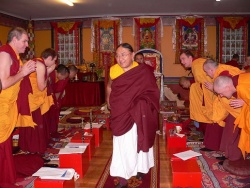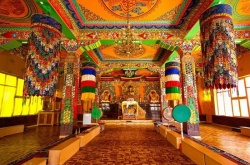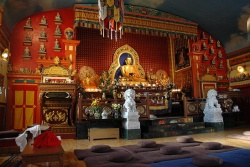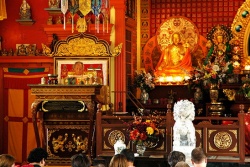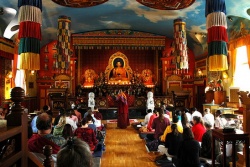Shrine room etiquette
In Dharma practice we engage our body, speech and mind to cultivate positive qualities and reduce our non-virtuous actions. The body, speech and mind are strongly connected and all our actions leave an impact on the mind. There are opportunities to practise mindfulness in everything we do, including our demeanour in the shrine room and in the presence of gurus, lamas and ordained Sangha. Part of the practice of making the shrine a sacred space is to leave ordinary activities, speech and thoughts outside.
Gurus, lamas and ordained Sangha
Bodhisattvas and monastics devote their lives to the Buddhadharma. They have often undertaken extensive training and, by years of study and practice, achieved a high degree of spiritual awareness. Their compassion extends to all beings, and their aspiration is to bring out the highest spiritual potential in everyone they encounter, as well as in themselves. For these reasons, they deserve not only courtesey and respect, but great consideration.
We can show gratitude and respect towards lamas in simple ways. A traditional Tibetan greeting is to offer a white silk scarf, or kata. If the lama is a high Rinpoche, and especially one's own teacher, it is customary to prostrate three times upon arriving and once when leaving, if it is a formal situation. The important thing is to acknowledge the lama as one would acknowledge any dignitary, in an appropriate way.
One should defer to lamas in every way possible - such as standing when they enter a room, offering them a chair and giving other assistance as needed. Their needs should be carefully looked after with keen observation as, not being grasping, they may not mention their needs even when asked. This can include simple things like making sure they have ample water or tea, adequate meals, or putting aside our own egoic requests when the lama may need time for rest or meditation.
Making requests
When requesting a teaching, empowerment or interview with a lama, it is appropriate and customary to bring an offering. Flowers, incenset and candles are symbolic offerings made to the purified Buddha-mind that you perceive in your teacher. Useful items are also good offerings; money is naturally a useful gift and may be offered in an envelope. Lamas have needs like anyone else, though theirs are very simple as a rule. Often gifts are immediately turned toward benefitting others, and any offerings made are more for the benefit of the donor than the lama him or herself, providing an opportunity for the student to express generosity.
The shrine room
A shrine room is a sacred space for us to contact the highest aspect of our nature, our own Buddha-nature, and should be approached respectfully with that in mind.
Shoes are removed and left at the door, and hats should not be worn. This is symbolic of leaving the dust and dirt of the mundane world outside (as well as a practical way to keep the shrine room clean). Short skirts or revealing garments are inappropriate attire - a shawl can be used to drape over the legs or shoulders while sitting.
In most Buddhist shrine rooms, seating is provided with cushions on a clean floor, and the acceptable posture is to sit cross-legged. If that is difficult due to physical problems, one can sit in a chair towards the back of the shrine room. Wherever possible, ones' seat should be lower than that of the lamas.
The cross-legged, or lotus posture, is universally used in the East as that which expresses and produces the attitude of contemplation, respect and receptivity to the teachings. Do not sit with legs outstretched in front of you, as this is a sign of disrespect, and of course, lying down shows great discourtesy. If you must stretch your legs when you are seated in the shrine room, please cover your feet and do not point your feet towards the shrine or lamas.
In the shrine room we try to offer the most pleasing sights, sounds, and smells and cause the least distraction to lamas, monastics and fellow students. To assist this, please keep your belongings tidy and to a minimum in the shrine room. Do not eat in the shrine room during teachings or engage in activities that might distract those who are in meditation. Voices should be lowered when talking, and ordinary conversation should be kept to a minimum in and around the shrine room.
Dhama texts and teachings
Dharma books and puja texts do not belong on the floor, out of respect for the precious words that they contain. Texts should always be placed on a table or cushion and never stepped over, stepped on or sat on. When the shrine room is crowded, please help others who are entering or leaving by picking up and holding your text.
Like the written Dharma, spoken Dharma is treated respectfully, and unless one is serving tea, or has a physical problem, one should not get up and walk in and out of teachings and pujas. It shows lack of consideration for others, who may be distracted, and disrespect for the teaching and the lama. During formal ceremonies such as pujas, the lama will normally indicate when students can take a break or leave freely.
Arriving and leaving
When entering the shrine room, it is customary to do three prostrations facing the shrine, to pay respect to the Buddha, Dharma and Sangha with our body, speech and mind. In formal settings, it is normal to prostrate upon our first entry of the day, and again on taking our final leave.
For teachings, be sure to be in the shrine room early so as not to arrive after the teacher. When the teacher enters and while he or she make their prostrations, we stand facing him or her with a slight bow and our palms together at the heart, to keep our heads lower than the teacher's. Once the teacher has taken his or her seat, and the other monastics have completed their prostrations, then we make our own prostrations toward the teacher.
At the end of a teaching, we stand as the teacher stands and again bow slightly with palms together, facing toward the teacher right up until he or she leaves the room. In formal settings, make three parting prostrations, except on the final session of the final day of instruction - to signify our desire that the teacher may soon return.
